
・「顔面神経管はフォロッピオ管と呼ぶのがふつうである。」(船戸和弥のHP)


【経過】
ここでは顔面神経管を以下のように4つに分けてみた。

1 |
入口から水平位に進む |
顔面神経管は内耳道底の4区分の1つである顔面神経野(横稜より上方で前部の方)の顔面神経管入口より始まる。まずは蝸牛の外側に沿ってほぼ水平位に前外方に走る。 |
2 |
ほぼ直角に曲がる |
続いて、ほぼ直角に後外方に曲がる。この曲がりを顔面神経管膝と呼ぶ。 |
3 |
鼓室の上部を通過 |
直角に曲がった後、鼓室壁の前庭窓の上を通って少し外後方に進む。前庭窓の上を通過するとき鼓室壁に隆起を形成し、これを顔面神経管隆起と呼ぶ。 |
4 |
弓状に下降して出口へ |
続いて、弓状をなして下降し茎状突起の根元のすぐ後方に茎乳突孔として開く |
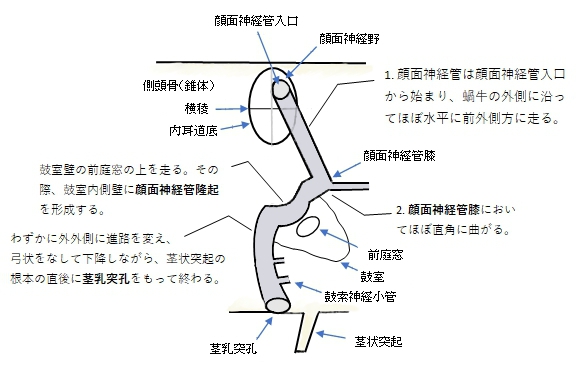
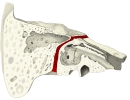
|
|
|
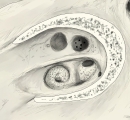
|
乳様突起~鼓室
(斜め?断面) |
右鼓室
(外側面・断面) |
右鼓室
(外側面・断面) |
右内耳道底 |
|
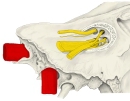
|
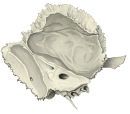
|
|
右側頭骨(上面)
|
内耳道底と神経 |
左側頭骨(内側面) |
|
「 船戸和弥のHP 」では以下のように解説している。
「顔面神経管は内耳孔に始まって茎乳突孔に終わる。顔面神経管は顔面神経の通路で、内耳道底にある横稜の顔面神経野にはじまり、まず蝸牛の外側に沿い殆ど水平位で前外方に進み、つぎにほぼ直角をなして後外方に曲がる。ここを顔面神経管膝という。ついで鼓室壁の前庭窓の上を通って少し外後方に進んだ後、下方へ向かって弓状に曲がり(この間、鼓室内側壁に顔面神経管隆起をつくる)、茎乳突孔に開く。
この間は膝で1条の枝を出し、骨を貫いて前進し錐体前面の大錐体神経管裂孔を出て大錐体神経溝につづき、大錐体神経管がこれを通る。『フォロッピオ管』:側頭骨錐体にある顔面神経管。イタリアの解剖学者Gabriele Fallopio [Fallopius](1523-1563)によるもので、他にファロピウス管(卵管)にも名を残す。両者を混同しないため、顔面神経管はフォロッピオ管と呼ぶのがふつうである。 」
また、以下は「Wikipedia」の解説文となる。
The facial canal (canalis nervi facialis), also known as the Fallopian canal, is a Z-shaped canal running through the temporal bone of the skull. It runs from the internal acoustic meatus to the stylomastoid foramen. It contains the facial nerve (CN VII), after which it is named.
【Structure】
The facial canal runs from the internal auditory meatus to the stylomastoid foramen. In humans it is approximately 3 cm long, which makes it the longest human osseous canal of a nerve. It is located within the middle ear region, according to its shape it is divided into three main segments: the labyrinthine, the tympanic, and the mastoidal segment. It contains the facial nerve (CN VII), after which it is named.
The labyrinthine segment runs from the internal auditory meatus to the geniculate ganglion, superior to cochlea. Initially, it runs anterolaterally before turning sharply posterolaterally at the geniculate ganglion (first bend of the facial canal). The tympanic segment starts from the geniculate ganglion and until the second bend of the facial canal. It is closely related to the posterior and medial walls of the tympanic cavity. It lies superior to the oval window and inferior to the lateral semicircular canal. The mastoid segment starts from the second bend of the facial canal, going downwards, towards the stylomastoid foramen. The narrowest part is located at the beginning of the labyrinthine segement and midpoint of tympanic segment.
【 語 句 】
・temporal bone:側頭骨 ・internal acoustic meatus:内耳道 ・stylomastoid foramen:茎乳突孔 ・facial nerve:顔面神経 ・labyrinthine:迷路性の、内耳性の ・tympanic:鼓膜の ・mastoidal:乳様の? ・geniculate ganglion:膝神経節 ・cochlea:蝸牛殻, 渦巻管. ・tympanic cavity:鼓室 ・oval window:卵円窓 ・lateral semicircular canal:外側(骨)半規管
【Prominence】
The prominence of the facial canal (or prominence of the aqueduct of Fallopius) indicates the position of the bony facial canal in which the facial nerve is contained; this canal traverses the medial wall of the tympanic cavity above the oval window, and behind this it curves nearly vertically downward along the posterior wall.
【Function】
The facial canal contains the facial nerve (CN VII), after which it is named. At the internal auditory meatus, the facial nerve together with its intermediate nerve, enters through the anterosuperior part, and the vestibulocochlear nerve enters through the posteroinferior part into the facial canal.
【 語 句 】
・prominence:突出部 ・aqueduct:水路 ・intermediate nerve:中間神経 ・vestibulocochlear nerve:内耳神経
■ 写真やイラストを掲載しているサイト ■
・ イラストや写真を掲載しているサイト-Ⅰ
・ イラストや写真を掲載しているサイト-Ⅱ
・ イラストや写真を掲載しているサイト-Ⅲ
・ イラストや写真を掲載しているサイト-Ⅳ
・ イラストや写真を掲載しているサイト-Ⅴ
